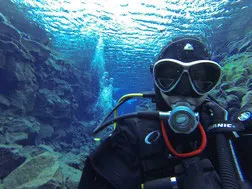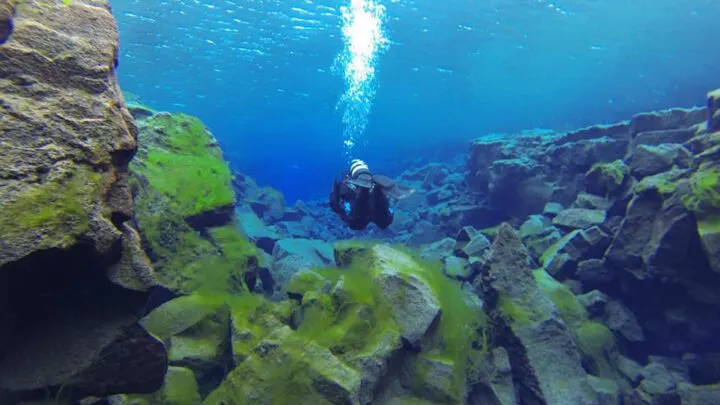We’ve all hear about scuba diving in Silfra – the only place in the world you can dive between the American and Eurasian continental plates, and touch both continents at the same time! We hand over to Girls that Scuba member Sigríður Lárusdóttir who lives and works in Iceland to tell us all about scuba diving in this magical place!
The water in Silfra is as clear as pure air, the landscape is breathtaking and the colours are beautiful. Visibility can be 100 meters plus, in fact, the water is so clean that you can take out your regulator and take a sip of the 3°c cold water, which has been filtered for hundreds of years through the lava. For me, it is paradise, and there’s no wonder why divers come from all over the world to dive in this continental rift between the North American and Eurasian tectonic plates. But it’s not only scuba divers; this is a heaven for free diving as well due to the numerous holes and cracks to go through; you can even meet an occasional trout resting.
As Iceland lies far north the temperature is not as most divers dream of, there are many things to take into consideration before dipping into the cold waters. In summertime the warmest waters are maximum 14°C and in winter it can go as cold as down to freezing point. Let’s discuss what you are going to need to bring:
What you will need to bring
- The suit. Drysuit and thick undergarment. Even two layers of undergarment is a must. It takes practise to dive in a drysuit so it is recommended to take a drysuit course before attempting to dive. I personally take on an inner layer of woolen long underwear, then a thermal insolation suit and at last the drysuit. Dry gloves are my choice with woolen under-gloves, but 5-7 mm wet gloves do just fine. And a hood is a must; 7 mm minimum at winter.
- Do not bring your own regulator unless it is made to tolerate frost. Freeflow is a common problem if the first and second stages are not made for extreme conditions. If the air temperature is below freezing point it is a must to test the second stage before entering the water. This is because even minimum condensation in the second stage freezes immediately and can get stuck or ever ruptures in the membranes.
- Remember: As plastic gets stiff in cold conditions, most of us here in Iceland use rubber fins.
- Hot drinks and a good buddy
More things to know before you go
There are not many active scuba divers in Iceland as there are only about 350.000 people. That gives us a lot of space to dive without being crowded and waiting in line. By far, most of the diving tourism evolves around Silfra and there it can get crowded with divers and snorkelers (well worth waiting though), but if you want to explore and go different places, just go for a hunt to find a private dive guide ( you can contact me on [email protected]) or go with your buddy. However, be well prepared and ask, ask more, and then ask some more – local divers here are nice people and are willing to share experience and give some advice and recommendations.
Don’t worry too much about the cold, as long as you have the right equipment and are well prepared you will hardly notice! Get ready for the dive of you life!
Check out this video of freediving with a scooter in Iceland!

About the Author
Sigga is a scuba and freediving enthusiast, certifieda AIDA 4 freediver and PADI Divemaster, just starting training for PADI instructor. She has been exploring the Icelandic waters for years, as well as every now and then dipping into warmer waters abroad. She has a B.Sc. in Biomedical Science and is a certified hypnotherapist. Hobbies: Scuba diving, free diving, skiing, hiking, weight lifting, swimming……just everything that makes her smile 😉 MOTTO: Live life instead of just surviving it! Follow her on Instagram here.

